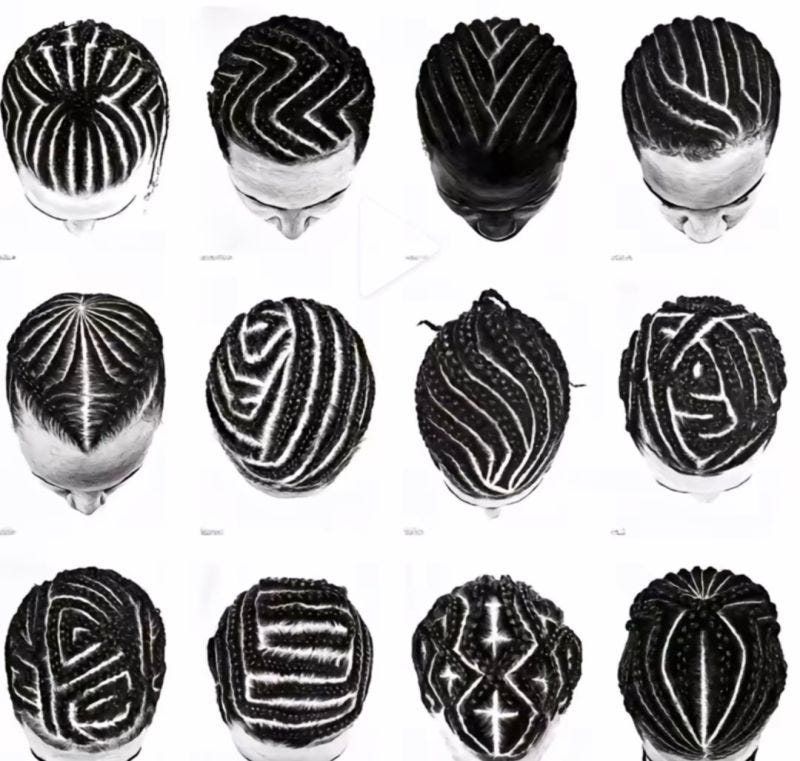Look at these patterns. Really look at them.
What you're seeing isn't just hairstyling - it's one of the most sophisticated communication systems ever created under oppression. Each intricate design represents centuries of African mathematical tradition, survival innovation, and quiet rebellion that saved countless lives.
The African Foundation
Long before the horrors of the Middle Passage, cornrows held profound meaning across African cultures. In ancient Egypt, cornrows indicated social status, age, and religious beliefs. Nubian queens wore elaborate braided crowns that took days to complete. In West Africa, the Yoruba, Mandinka, and Wolof peoples developed distinct braiding languages - each pattern telling stories of family lineage, spiritual beliefs, and community belonging.
The mathematical precision required was extraordinary. Master braiders calculated angles, measured symmetry, and created geometric patterns that would make modern mathematicians marvel. This wasn't simple hairstyling - it was applied engineering, passed down through generations of women who understood that beauty and intelligence were inseparable.
The Middle Passage and Cultural Erasure
When millions of Africans were forced onto slave ships, captors deliberately separated people who spoke the same languages. They understood that communication meant resistance. But they couldn't strip away the knowledge encoded in hair.
Enslaved women arriving in the Americas carried centuries of braiding wisdom in their muscle memory. In a world designed to erase their identity, their hair became their library, their communication network, their act of preservation.
The Secret Language Emerges
The term "cornrows" emerged between the 16th and 19th centuries in colonial America, named for their resemblance to the agricultural fields where enslaved people labored. In the Caribbean, they became "canerows" after the sugarcane plantations. But beneath these colonial names lived a revolutionary system.
When literacy was criminalized for enslaved people, Black women transformed their hair into a sophisticated communication network. This wasn't metaphorical - it was literal life-saving information transfer.
Specific patterns carried coded messages: certain curved designs represented escape routes toward freedom. The number of braids could indicate timing for planned escapes. Braid directions pointed toward safe houses. A particular style might signal that it was time to run, or that danger was approaching.
The complexity was remarkable. Women had to memorize not just the patterns, but their meanings, their variations, and how to teach them without arousing suspicion. They created a language that lived on their heads, impossible to confiscate or destroy.
The Survival Toolkit
But the ingenuity went beyond communication. Women would braid gold, seeds, and small amounts of food directly into their hair - creating a survival kit hidden in plain sight. Rice and other seeds could later be planted to provide nourishment in freedom. Gold could be traded for safety or passage. Medicine, small tools, even maps were woven into elaborate styles.
Imagine the planning required. Each braid had to look natural while serving multiple functions. Each style had to pass inspection while carrying enough resources to sustain a journey toward freedom. The mental calculation, the risk assessment, the sheer courage - it takes your breath away.
The Mathematics of Resistance
The geometric precision required for these patterns represented intellectual sophistication that the world refused to acknowledge. Creating perfect symmetry across a curved surface, calculating angles, maintaining consistent spacing - this required advanced spatial reasoning and mathematical understanding.
Yet society insisted these women were intellectually inferior. Meanwhile, they were literally wearing proof of their genius, growing evidence of their innovation from their scalps every single day.
Modern Echoes and Workplace Reality
Today, when someone dismisses cornrows as "unprofessional" or adopts them as a trend without context, they're continuing this erasure. They're reducing survival to fashion, minimizing genius to aesthetics.
The same patterns that once meant freedom are now banned in schools and workplaces. The same styles that demonstrated mathematical precision are called "distracting" or "inappropriate." The disconnect is staggering - and revealing.
Understanding this history transforms how we see natural Black hair in professional settings. It's not just about personal choice or cultural expression. It's about recognizing and respecting a tradition of intellectual achievement, creative problem-solving, and unbreakable resilience.
The Legacy Lives On
Every cornrow today carries this history. Every braid connects to women who refused to let oppression silence them. Every pattern honors ancestors who transformed beauty into resistance, art into communication, and survival into legacy.
When we honor cornrows within their full cultural context, we're not just appreciating hairstyling - we're celebrating human ingenuity under impossible circumstances. We're recognizing that Black women have always been innovators, mathematicians, communicators, and leaders, whether the world acknowledged it or not.
The sacred language of cornrows reminds us that creativity and intelligence flourish even in the darkest circumstances. That beauty can be revolutionary. That resistance takes many forms.
And that sometimes, the most powerful messages are written not in books, but in the patterns we wear with pride.
What cultural traditions do you think hold deeper meanings than we realize?
Hit reply and tell me - I read every response.
(These images are by the amazing painter and visual artist So Yoon Lym.)






Abi, my lovely - this is a fecking AWESOME piece! 🫶🫶🫶
Like pretty much every white person on the planet, I thought cornrows always looked really cool (not on whites though - ugh) but had no idea about the secret language they represented - let alone the mathematical skills required!
Thank you so much for sharing your knowledge and passion about this with me (and the RoW).
Omg Abby I never new that about early African American culture I knew about the food but because of African culture